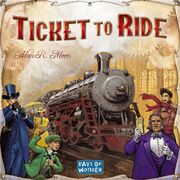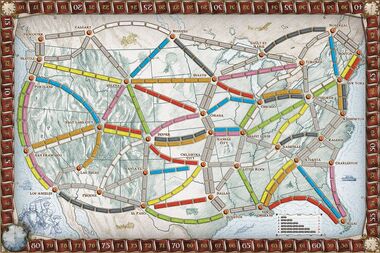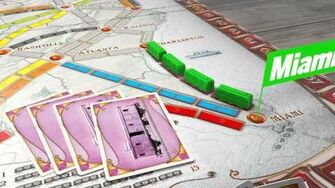Ticket to Ride is the first game of the series of the same name. It is a 2-5 player card drafting and track-laying game set in the USA.

Components[]
- 45 train cars for each color (blue, green, red, yellow, and black)
- Spare cars
- 5 wooden score markers
- Rules booklet with a Days of Wonder access code
- 144 cards (1 player guide, 2 promotional cards, 30 destination tickets , 110 train cards (12 in each color, 14 wilds)

Setting up[]
- Place the board onto the table
- Sit down and take the 45 train cars (be sure to count them), and the scoring marker of your color.
- Place the scoring marker on the border at the 100 point.
- Place the destination tickets and the train cards face down onto the table (be sure to shuffle all of them well), and give 3 destination tickets and 4 train cards to each player (do NOT reveal any of these). Also, place 5 train cards face up on the table next to the train card pile.
- Look at your destination tickets and take at least 2. Place discarded tickets at the bottom of the pile. The number on the tickets is the amount of points associated with that card. You'll lose those points if you don't finish them, but will get those points if you do.
- You may begin.
How to play[]
Win by getting the most points. Points are scored by claiming routes, finishing destination tickets, and getting the longest continuous path.
The most experienced traveler goes first. Play goes clockwise around the table. You can do 3 things on your turn.
- Collect train cards
- Claim a route with said train cards
- Take more destination tickets
When taking trains, you can take 2 in one turn. You may choose from the cards face up on the table, or from the face down deck. You may mix and match. However, the wilds (the train cards with a locomotive) are special. When drawing a face-up locomotive, that counts as two cards. You may not take a green card and then a wild. When you collect cards, put them in your hand.
Placing a route requires the aforementioned train cards. To claim Omaha to Chicago, for example, you need 4 blues (and wilds if you need to do so), because there are 4 blue spaces. Gray routes are neutral, and may be claimed with that number of identical cards. For example, you may claim Duluth to Sault Ste. Marie with 3 reds, but not 2 reds and a green. You may only claim routes that haven't yet been claimed. Some routes are double-routes. In 2 or 3 player games, once one is claimed, the other can't be. In a 4-5 player game, both are opened.
When you claim a route, you receive points as follows:
1 space gets 1 point
2 spaces get 2 points
3 spaces get 4 points
4 spaces get 7 points
5 spaces get 10 points
6 spaces get 15 points
Move the score marker up the track when you get points. You may also choose to score the routes up at the end to increase tension.
You may (when ready) take more destination tickets for your turn. Take three destination tickets off the top of the deck and look at them. You must take at least one. You can take as many destination tickets as you want.
When a player ends their turn with 2 or less cars left, every player gets one last turn including the aforementioned player. Afterwards, the game ends.
At the end of the game, first calculate the points earned by routes if you haven't already. Then have everyone show their destination tickets. If a ticket is complete, they get those points. If they aren't complete, you lose those points. After that, decide who has the longest continuous path and give them 10 points . You should have a winner!
In a tie, the one with the most tickets wins. If it's still a tie, the one with the longest contiguous path wins!
Trivia[]
- This map is set in 1900. However, the city of Las Vegas was not founded until 1905. In fact, it would not become a notable town until after the legalization of gambling in 1931 and the construction of the Hoover Dam.
- The lore of the game does not match the gameplay. The lore says the bet was to go to the most cities, although the game makes you build to certain cities.
- The lore says the five friends went to university together, but the green boy does not seem old enough to be in the same university class as the others. In fact, none of them seem the same age.
- Some cities were moved in order to make the map work. The two biggest moves are Duluth (which was planned to be St. Paul, but changed last minute) and Boston (which is in Maine).
Awards[]
- 2004 Spiel des Jahres
- 2004 Origins Awards Best Board Game Winner
- 2004 Japan Boardgame Prize Best Advanced Game Winner
- 2004 Jeux sur un plateau gold award
- 2004 Bruno Faidutti – Game of the Year
- 2004 Parents' Choice Foundation - Silver Honor
- 2004 Games Magazine - Game 100
- 2004 Best Family Game - Boardgamerating.com
- 2004 Meeples' Choice Award
- 2004 Schweizer Spielepreis, 2d for Family Games
- 2004 Deutscher Spiele Preis, 6th
- 2004 Tric Trac nominee (France)
- 2004 Nederlandse Spellenprijs Nominee
- 2004 International Gamers Awards – General Strategy; Multi-player Nominee
- 2005 Diana Jones Award for Excellence in Gaming - Winner
- 2005 As d'Or jeu de l'année - Cannes
- 2005 Årets Spel Best Family Game Winner
- 2005 Juego del Año Winner
- 2005 Vuoden Peli Family Game of the Year Winner
- 2006 Hra roku Winner
- 2006 Japan Boardgame Prize Best Japanese Game Winner
- 2008 Ludoteca Ideale Official Selection
- 2010 Hungarian Board Game Award Nominee

